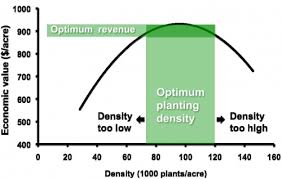If you want to provide what you need yourself, it is helpful to have an idea about how much crop you should sow or plant to be sufficient (with a family) for one year. But that is not to express in exact figures. The yield of a crop depends inter alia on the following factors:
soil (sand, silt, clay, humus), fertilization, weather (drought, too wet), water (irrigation, drainage), engineering (mechanical, intensive), region (north, south), location (sun, wind), year, early or low variety, cultivation, varieties and species, predation and disease, time of sowing and reaping... and all these factors influence each other.
But based on averages for large-scale farming in the early 21st century, we can give a rough idea.
 For some crops, there is little information available, in others the yield is not expressed in tonnes / ha, but e.g. in little bunch (parsley), tuber (fennel, celery), etc.
For some crops, there is little information available, in others the yield is not expressed in tonnes / ha, but e.g. in little bunch (parsley), tuber (fennel, celery), etc.
It is not always clear what weight is specified, gross weight or net sellable or edible yield without e.g. cabbage stalks, beet - or root leaves, husks and straw, pods etc. Many of that ’waste' of course is excellent fodder and bedding.
One hectare (ha) is 100 m × 100 m = 10,000 sqm (m2).
Measure a piece of 3.3 x 3.3 meters, about the size of a small bedroom or kitchen in your garden, then you have about 10 m2. That might be easier to understand and oversee. So divide the harvest thus by 1,000, or you just drop the 000 zeros after the comma.
Of course you do not need just kilograms yield, but also varied and healthy diet.
In organic farming, the yield would be about 20% lower in quantity
wheat 8,000 kg / ha
barley 7,000 kg / ha
potatoes 45.000 kg / ha
beet 70,000 kg / ha, accounting for approximately 11,000 kg of sugar
onion 46,000 kg / ha
winter rape 5,000 kg / ha
peas 4,000 kg / ha
beans 3,000 kg / ha
carrots 40,000 kg / ha
tomatoes 5,000 kg / ha
chicory 350,000 kg / ha
leek 30,000 kg / ha
Brussels sprouts 20,000 kg / ha
broccoli 8,000 kg / ha
zucchini 3,000 kg / ha
Chinese cabbage 30,000 kg / ha
flax 6,600 kg of straw and 900 kg grain / ha
apples 40,000 kg / ha (13 yrs, from 5th yr)
pears 25,000 kg / ha (35 yr, from the 7 yr)
wine in the Netherlands: 5,000 l or 6,500 bottles / ha
How many seeds do you need on a plot?
The ratio between the quantity of seed and the crop yield is called the seed to crop ratio. It is the percentage of the harvest that is stored and needed to be able to sow sufficient on the plots the next year.
If 180 kg per hectare is needed for sowing wheat, and that yields 7,500 kg, then the seed to crop ratio is 180/ 7,500 = 0.024 or 2.4% of the harvest that should be stored for seeds. Usually, however seed is grown apart.
The relationship between harvest weight and seed weight is dependent on the above- mentioned crop yield factors. Also germination, picking by birds, fungi, temperature, seeding distances and fertilizing play a role.
Guidelines for sowing density are sometimes given in number of seeds per linear (row crops) or per square meter (or hectare) (broadcasting the seed). For very small for seeds, they be can mixed with dry sand of approximately the same grain thickness, so as not to to sow too close the seeds. Usually seeds are traded per kilogram or gram. An indication of the number of seeds is given by the thousand grain weight. The TGW is the weight of 1000 seeds. In the Brussels sprouts of this, depending on the breed, is 3 to 4 grams. (Or one gram contains between 220 and 333 seeds).
Some approaches of required amount of seed per hectare:
Rapeseed 3-8 kg
Wheat 45-55 kg
Barley 100-180 kg
Buckwheat 30 -45 kg
Luzerne 5 kg
Grass 45-80 kg
Clover 8-15 kg
Flax 120 kg
